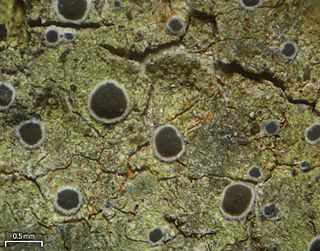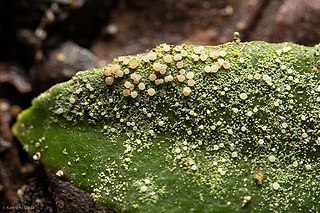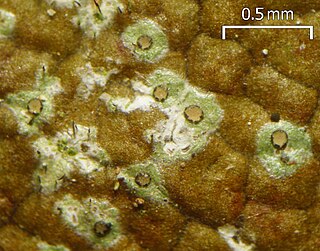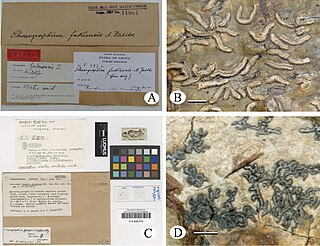
The Pilocarpaceae are a family of crustose lichens in the order Lecanorales. The species of this family have a cosmopolitan distribution and have been found in a variety of climatic regions. Pilocarpaceae was circumscribed by Alexander Zahlbruckner in Adolf Engler's influential 1905 work Die Natürlichen Pflanzenfamilien.

Bacidina is a genus of lichens in the family Ramalinaceae. It was circumscribed by Czech lichenologist Antonín Vězda in 1990, with Bacidina phacodes assigned as the type species. Vězda included 11 species in Bacidina, which was originally classified in the Lecideaceae. These species had previously been placed in genus Bacidia.

The Gomphillaceae are a family of lichen-forming fungi in the order Graphidales. Species in this family are found mostly in tropical regions.

Porina is a genus of lichens in the family Trichotheliaceae. A 2020 estimate places about 145 species in the widespread genus.

Fellhanera is a genus of mostly leaf-dwelling lichens in the family Pilocarpaceae. The genus, circumscribed by lichenologist Antonín Vězda in 1986, honours Austrian lichenologist Josef Hafellner.

Calopadia is a genus of foliicolous (leaf-dwelling) lichens in the family Pilocarpaceae. It was circumscribed by Czech lichenologist Antonín Vězda in 1986.

Byssoloma is a genus of leaf-dwelling lichens in the family Pilocarpaceae.
Actinoplaca is a genus of fungi within the Gomphillaceae family.
Aderkomyces is a genus of lichens in the family Gomphillaceae. It was circumscribed by Brazilian mycologist Augusto Chaves Batista in 1961.
Arthotheliopsis is a genus of fungi in the family Gomphillaceae. It has 5 species. The genus was circumscribed by Finnish lichenologist Edvard August Vainio in 1896, with A. hymenocarpoides assigned as the type species.
Echinoplaca is a genus of lichens in the family Gomphillaceae.

Gomphillus is a genus of lichen-forming fungi in the family Gomphillaceae.
Gyalectidium is a genus of lichen-forming fungi in the family Gomphillaceae. A 2020 estimates placed 52 species in the genus. The genus was circumscribed by Swiss lichenologist Johannes Müller Argoviensis in 1881. He included 3 species: G. xantholeucum, G. dispersum, and G. filicinum; the last of these is now the type species of the genus.

Gyalideopsis is a genus of lichens in the family Gomphillaceae. The genus was circumscribed by Czech lichenologist Antonín Vězda in 1972.
Jamesiella is a genus of fungi in the family Gomphillaceae. It was circumscribed by Robert Lücking, Emmanuël Sérusiaux and Antonín Vězda in 2005. The genus name honours Peter Wilfred James, an English botanist who worked at the Natural History Museum, London. The type species of the genus, Jamesiella anastomosans, is now classified in the genus Gyalideopsis.
Lithogyalideopsis is a genus of lichen-forming fungi in the family Gomphillaceae.

Tricharia is a genus of lichens in the family Gomphillaceae. It has an estimated 30 species.
Antonín (Toni) Vězda was a Czech lichenologist. After completing a university education that was postponed by World War II, Vězda taught botany at the Czech University of Life Sciences. In 1958, he was dismissed from his university position as a result of the restrictions placed on academic freedoms by the communist regime in power. He eventually was hired as a lichen researcher by the Czechoslovak Academy of Sciences, who allowed him to work from his apartment, which served also as an office and herbarium.
Arthotheliopsis serusiauxii is a species of leaf-dwelling lichen in the family Gomphillaceae. It was first formally described as a new species in 1997 by Robert Lücking, as a member of genus Echinoplaca. The type specimen was collected in Costa Rica, growing on the leaves of a dicotyledon. The specific epithet honours Belgian lichenologist Emmanuël Sérusiaux. In 2005, Lücking, Sérusiaux, and Antonín Vězda transferred it to genus Arthotheliopsis after a molecular analysis of the Gomphillaceae helped to clarify the phylogenetic relationships in the family.

Graphidales is an order of lichen-forming fungi in the class Lecanoromycetes. It contains 6 families, about 81 genera and about 2,228 species. Family Graphidaceae are the largest crustose family within Graphidales order comprising more than 2000 species, which are widely distributed in tropical and subtropical regions of the world.








